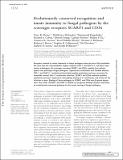| dc.contributor.author | Means, Terry K. | |
| dc.contributor.author | Mylonakis, Eleftherios | |
| dc.contributor.author | Tampakakis, Emmanouil | |
| dc.contributor.author | Colvin, Richard A. | |
| dc.contributor.author | Seung, Edward | |
| dc.contributor.author | Puckett, Lindsay | |
| dc.contributor.author | Tai, Melissa F. | |
| dc.contributor.author | Stewart, Cameron R. | |
| dc.contributor.author | Pukkila-Worley, Read | |
| dc.contributor.author | Hickman, Suzanne E. | |
| dc.contributor.author | Moore, Kathryn J. | |
| dc.contributor.author | Calderwood, Stephen B. | |
| dc.contributor.author | Hacohen, Nir | |
| dc.contributor.author | Luster, Andrew D. | |
| dc.contributor.author | El Khoury, Joseph | |
| dc.date.accessioned | 2010-03-03T15:49:07Z | |
| dc.date.available | 2010-03-03T15:49:07Z | |
| dc.date.issued | 2009-03 | |
| dc.date.submitted | 2008-09 | |
| dc.identifier.issn | 0022-1007 | |
| dc.identifier.uri | http://hdl.handle.net/1721.1/52003 | |
| dc.description.abstract | Receptors involved in innate immunity to fungal pathogens have not been fully elucidated. We show that the Caenorhabditis elegans receptors CED-1 and C03F11.3, and their mammalian orthologues, the scavenger receptors SCARF1 and CD36, mediate host defense against two prototypic fungal pathogens, Cryptococcus neoformans and Candida albicans. CED-1 and C03F11.1 mediated antimicrobial peptide production and were necessary for nematode survival after C. neoformans infection. SCARF1 and CD36 mediated cytokine production and were required for macrophage binding to C. neoformans, and control of the infection in mice. Binding of these pathogens to SCARF1 and CD36 was β-glucan dependent. Thus, CED-1/SCARF1 and C03F11.3/CD36 are β-glucan binding receptors and define an evolutionarily conserved pathway for the innate sensing of fungal pathogens. | en |
| dc.language.iso | en_US | |
| dc.publisher | Rockefeller University Press | en |
| dc.relation.isversionof | http://dx.doi.org/10.1084/jem.20082109 | en |
| dc.rights | Attribution-Noncommercial-Share Alike 3.0 Unported | en |
| dc.rights.uri | http://creativecommons.org/licenses/by-nc-sa/3.0/ | en |
| dc.source | Publisher | en |
| dc.title | Evolutionarily conserved recognition and innate immunity to fungal pathogens by the scavenger receptors SCARF1 and CD36 | en |
| dc.type | Article | en |
| dc.identifier.citation | Means, Terry K. et al. “Evolutionarily conserved recognition and innate immunity to fungal pathogens by the scavenger receptors SCARF1 and CD36.” The Journal of Experimental Medicine 206.3 (2009): 637-653. | en |
| dc.contributor.department | Broad Institute of MIT and Harvard | en_US |
| dc.contributor.approver | Means, Terry K. | |
| dc.contributor.mitauthor | Means, Terry K. | |
| dc.contributor.mitauthor | Hacohen, Nir | |
| dc.relation.journal | Journal of Experimental Medicine | en |
| dc.eprint.version | Final published version | en |
| dc.type.uri | http://purl.org/eprint/type/JournalArticle | en |
| eprint.status | http://purl.org/eprint/status/PeerReviewed | en |
| dspace.orderedauthors | Means, T. K.; Mylonakis, E.; Tampakakis, E.; Colvin, R. A.; Seung, E.; Puckett, L.; Tai, M. F.; Stewart, C. R.; Pukkila-Worley, R.; Hickman, S. E.; Moore, K. J.; Calderwood, S. B.; Hacohen, N.; Luster, A. D.; El Khoury, J. | en |
| mit.license | PUBLISHER_CC | en |
| mit.metadata.status | Complete | |
